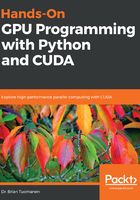
Checking your hardware (Linux)
We will now do a few basic checks in Linux to ensure that we have the right hardware. Let's first open up a Terminal and drop to the bash command line—you can do this quickly in Ubuntu by pressing the combination Ctrl + Alt + T.
Let's now check our processor by typing lscpu and pressing Enter. A lot of information will appear, but just look at the first line and make sure that the architecture is indeed x86_64:

Next, we check our memory capacity by typing free -g at the bash prompt and then again press Enter. This will tell us the total number of proper memory that we have in gigabytes in the first entry of the first row, as well as the amount of memory in swap space in the following row:

This is certainly sufficient memory.
Finally, let's see whether we have an appropriate GPU. NVIDIA GPUs communicate with our PC via the PCI bus, so we can use the lspci command to list all PCI hardware. There is usually a lot of other hardware listed, so let's use the grep command to filter for just NVIDIA GPUs by entering lspci | grep -e "NVIDIA" at the bash prompt:

This is a GTX 1070, which fortunately exceeds our need for at least a GTX 1050.